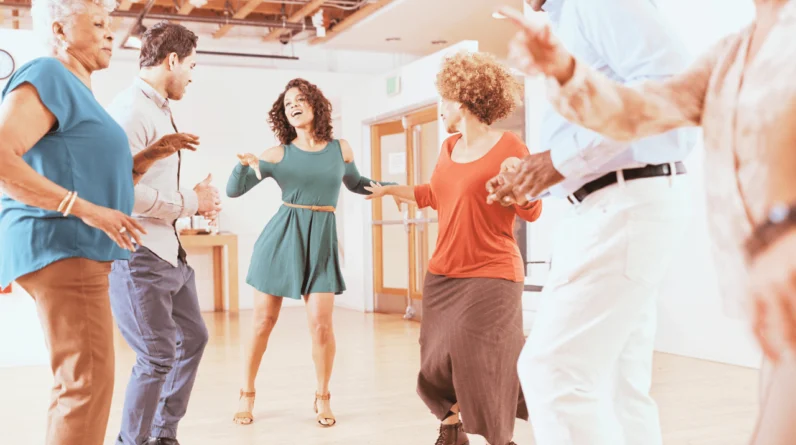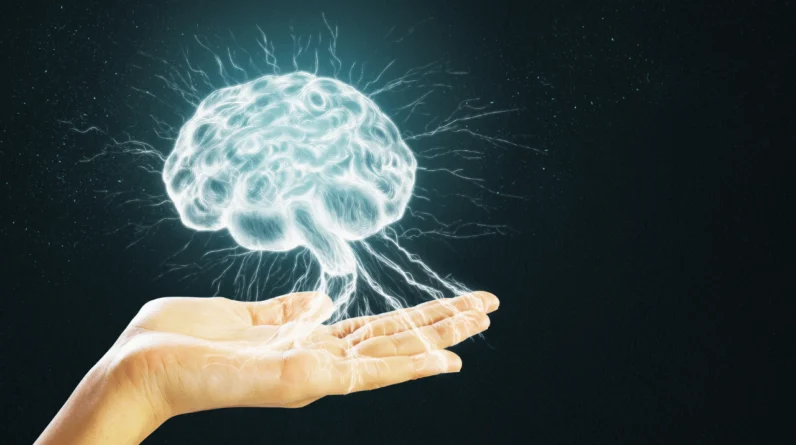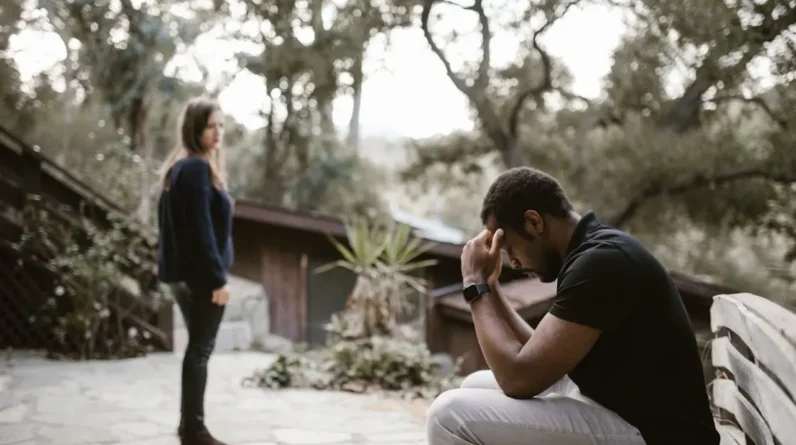
In today’s fast-paced and demanding world, anxiety has become a common struggle for many people.
With the constant pressure to perform, meet deadlines, juggle various responsibilities, and worldwide concerns, it’s no wonder that anxiety has become so prevalent in modern society!
Anxiety can manifest in various ways, such as:
- excessive worry
- restlessness
- racing thoughts
- and even physical symptoms like increased heart rate and difficulty breathing
However, there is hope for those who are seeking relief from anxiety in traditional and not-so traditional ways.
Dance/Movement Therapy
One alternative anxiety-reduction method that has gained recognition is dance/movement therapy.
This innovative approach utilizes the power of movement and expression to help you manage your anxiety and find inner peace.
Known by some as conscious dance, this form of therapy encourages:
- self-discovery
- emotional release
- a deeper connection with yourself
By incorporating movement and dance into anxiety management techniques, you can tap into your creative side and find a sense of freedom and joy that can decrease or alleviate stress and anxiety.
Understanding Dance/Movement Therapy
Dance/movement therapy is a holistic approach that recognizes the mind-body connection and aims to integrate movement and expression to facilitate healing and personal growth.
The fundamental principles of dance/movement therapy revolve around the belief that movement is a universal language that can be used to access and express emotions, memories, and experiences.
A dance practitioner creates a safe and supportive environment where you can explore and process your feelings through movement.
What sets dance/movement therapy apart from traditional forms of dance is its focus on the therapeutic aspects of movement, rather than the aesthetic or technical aspects.
While traditional dance may emphasize perfecting technique or creating visually pleasing performances, dance/movement therapy places importance on your internal experience and the therapeutic benefits of movement.
It is not about looking cool or achieving a particular dance style or skill level, but rather about using movement as a tool for:
- self-expression
- self-discovery
- healing
Essentially, dancing helps us connect with our emotions. Movement has the power to tap into our subconscious mind, allowing us to access and express emotions that we’ve been repressing or may be difficult to verbalize.
Through conscious dance, we can release pent-up emotions, reduce stress, and gain insight into our own patterns of movement and behavior.
It helps to establish a deeper connection with ourselves and others, fostering self-awareness, empathy, and personal growth.
The Science Behind Conscious Dance
Often, dance or movement therapy has anxiety-reducing effects.
This is due to the complex interplay of neurological and psychological mechanisms involved in the process. Neurologically, when we engage in movement and dance, our brain releases endorphins, which are natural chemicals that act as painkillers and mood enhancers.
These endorphins create a sense of euphoria and pleasure, helping to alleviate anxiety and stress. Additionally, movement stimulates the release of serotonin and dopamine, neurotransmitters that regulate mood and emotions, further contributing to the reduction of anxiety.
Psychologically, dance therapy allows us to express our emotions and release pent-up tension through movement.
It provides a safe and non-judgmental space for us to explore our feelings and connect with our bodies. By engaging in conscious dance, we can tap into our creativity and self-expression, which can be incredibly empowering and therapeutic.
The act of moving freely and expressing yourself through dance can help you release negative emotions and reframe your thoughts, leading to a reduction in anxiety.
How Dance/Movement Therapy Helps with Anxiety
Mindfulness and being present in the moment play a crucial role in dance/movement therapy.
When you are fully present and focused on the movements and sensations of your body, you are able to connect with your emotions and experiences on a deeper level. It allows you to fully experience and process your feelings without getting caught up in past or future thoughts.
By being mindful and present, you can gain insight into your thoughts, emotions, and behaviors, leading to increased self-awareness and personal growth. It also helps you to develop a stronger mind-body connection and promotes overall well-being.
A Personal Story – I Tried Movement Therapy
When I walked into a conscious dance event in my community for the first time, my heart raced with anxiety and fear of what lay ahead. All of my life, I was afraid to dance in public, but I really wanted to get rid of this fear.
At first, I was very self-conscious, but as I let the music guide my movements and realized no one was judging me, something amazing began to unfold.
Sure, in the beginning, each step felt uncertain, like a puzzle piece I wasn’t sure how to fit. As time passed, though, the music started leading the way. It was as if the rhythm itself carried away some of my anxiety.
The dance floor transformed into a place where I felt free among others who felt free, where the weight of anxiety seemed to lighten.
Finding a New Language
Through conscious dance, I found a new language in movement. My body, which I had overlooked in the busyness of life, started to speak. With each spin and sway, anxiety’s hold on me weakened. I began to experience a sense of freedom in that space I hadn’t known before.
This change didn’t happen overnight, but I began noticing that the music’s embrace and the way my body connected with it slowly worked to melt away my fears.
Conscious dance in the community and at home has become a path for me to release much of the anxiety I’d been carrying and to open up to the beauty of the unknown. I’ve learned that by facing my fears and dancing through them, I can find a sense of liberation and ease the weight of anxiety’s burden.
Incorporating Dance/Movement Therapy into Daily Life
Integrating dance/movement therapy into your daily routine can have numerous benefits, including:
- stress reduction
- increased body awareness
- improved emotional expression
To get started, try incorporating simple dance or movements into your day.
For example, you can start your morning with a conscious dance session, where you let your body move freely and expressively to your favorite music. This can help you release any tension or emotions built up from the previous day. It also sets a positive tone for the day ahead.
Also, many dance practitioners offer online classes or tutorials specifically designed for home practice.
These classes cater to all levels, from beginners to advanced practitioners, so you can find one that suits your needs and abilities. Here are some to consider:
Embodiment dances in the community, also known as conscious dance events, are a wonderful way to connect with our bodies and explore our inner selves. There are several different types of embodiment dances, each offering a unique experience.
One such dance is 5Rhythms, which encourages participants to move through five distinct rhythms:
- flowing
- staccato
- chaos
- lyrical
- stillness
Each allows for a complete expression of emotions and energy.
Another type of embodiment dance is Ecstatic Dance, where you are free to move and groove in whatever way feels most authentic to you. This type of dance is often accompanied by uplifting music and creates a space for self-expression and connection with others.
Still another is Azul Conscious Dance founded by Amara Pagano.
No matter which type of embodiment dance you choose to explore, you can be sure that it will provide a safe and nurturing environment for self-discovery and personal growth.
Remember, the most important thing is to have fun and be kind to yourself as you explore dance/movement. Give yourself permission to let go of any self-judgment and simply enjoy the experience of moving your body in a way that feels good to you.
Conclusion
In conclusion, dance/movement therapy has shown great potential as a viable approach to easing anxiety.
Through the use of conscious dance, you are able to:
- tap into your emotions
- express yourself freely
- release any pent-up stress or tension
This alternative method offers a unique and engaging way to address anxiety, providing you with a safe space to explore your feelings and connect with your body.
I encourage you to explore this alternative method and discover its benefits for yourself. You may be pleasantly surprised by the positive impact it can have on your mental and emotional well-being.
Editor’s note: This article was originally published Aug 15, 2023 and has been updated to improve reader experience.







